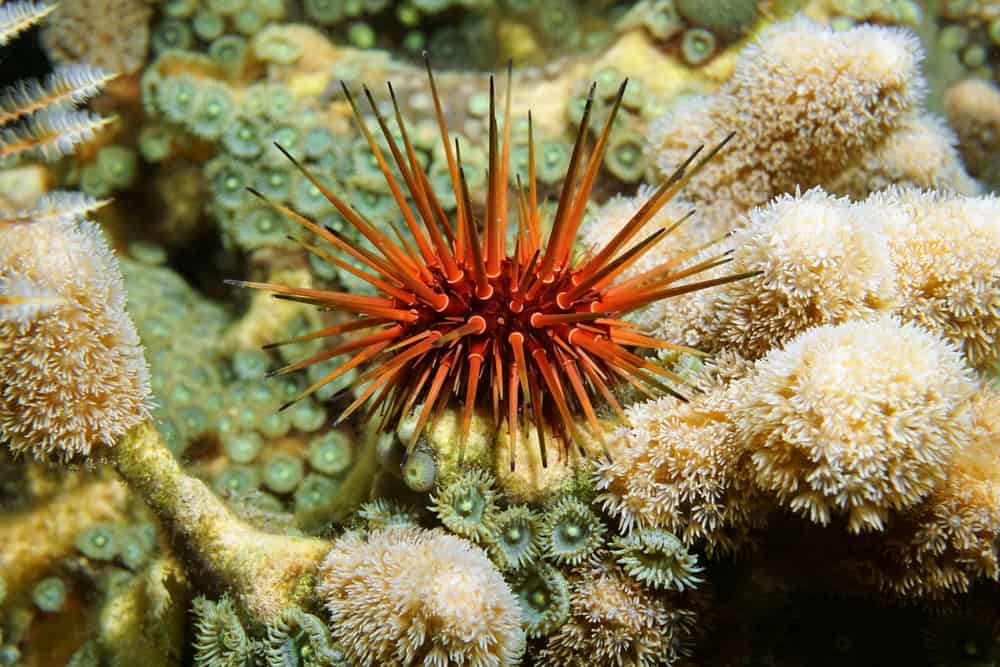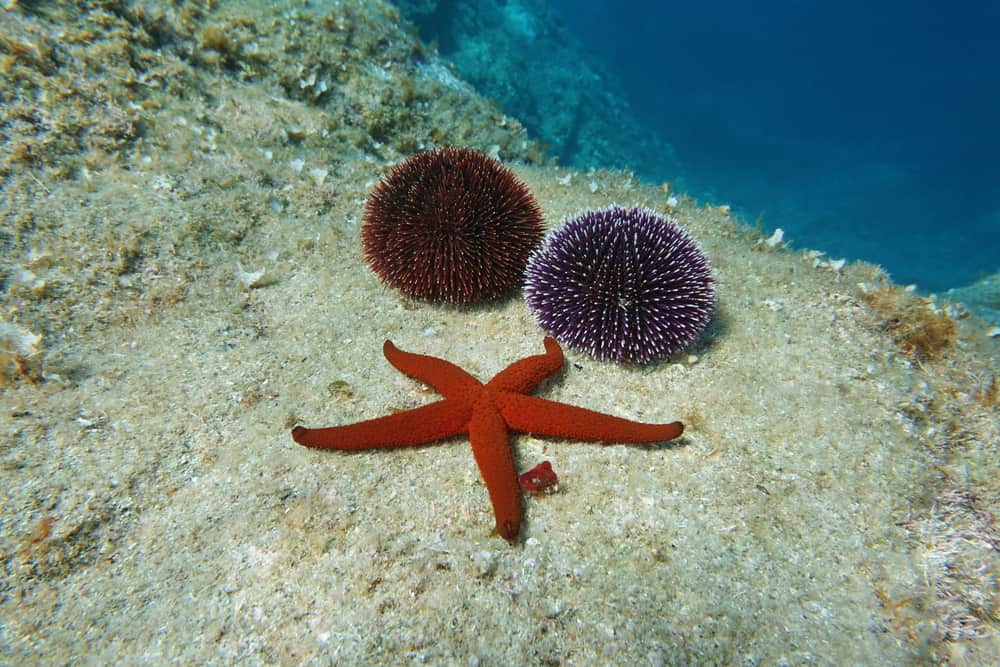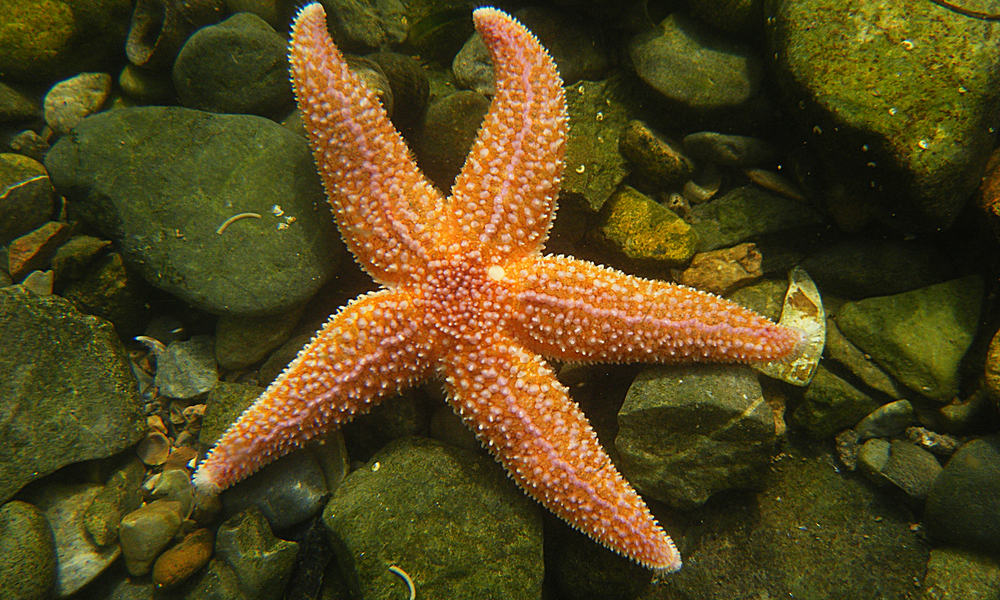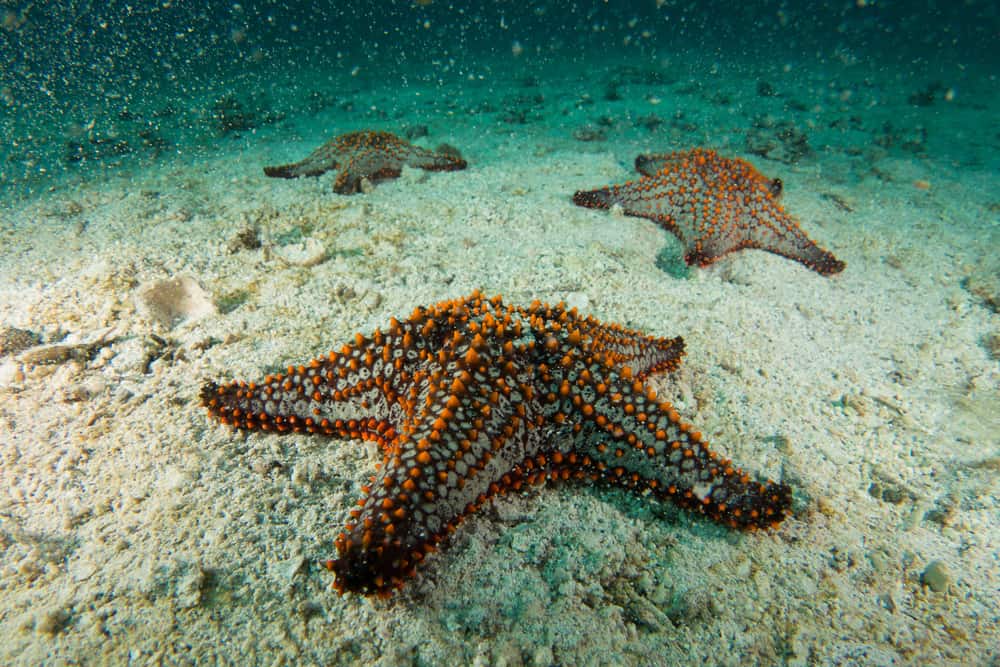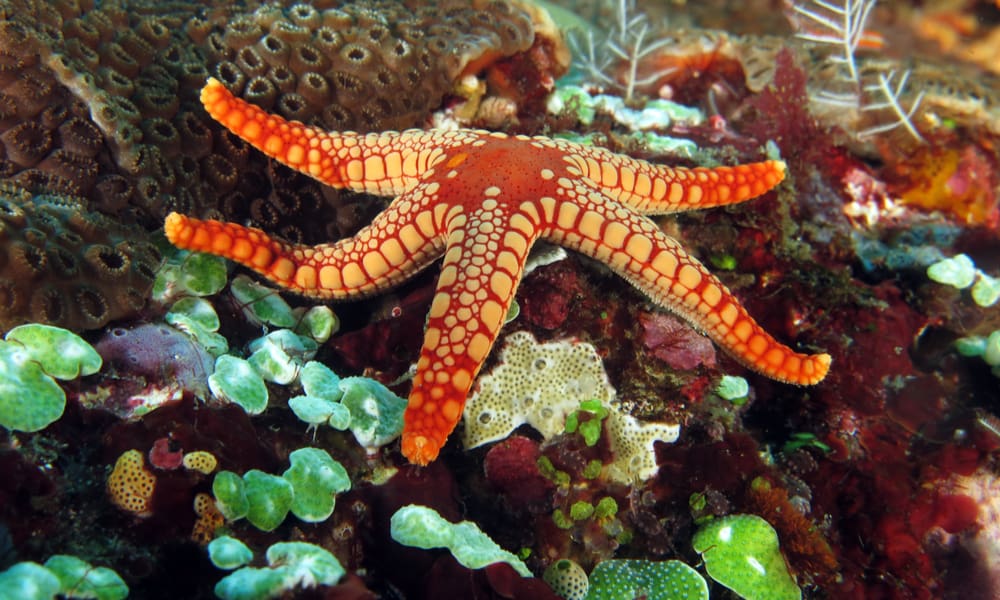You are probably most familiar with echinoderms like sea stars, sand dollars, cucumbers, and even sea urchins. These ancient marine animals inspire the curiosity of divers and children alike (thanks to Patrick Star of Spongebob Squarepants).
If you have your wet suit on, let us take a dive into the blue and discover more about echinoderms.
Echinoderm Habits and Biology
Echinoderms are fairly sophisticated animals despite their simple appearance. Furthermore, this marine animal group’s fossil record (13,000 extinct species) dates back to the Cambrian period (542 million years ago), which is more than enough evidence to prove its tenacity as a species.
Today’s living echinoderm species exist amongst the following classes:
- Crinoidea- sea lilies
- Echinoidea- sea urchins and sand dollars
- Holothuroidea- sea cucumbers
- Asteroidea- sea stars
- Ophiuroidea- brittle stars
The various classes of echinoderms share several characteristics in common with one another. One of its more visible traits comes from looking at the etymology of the word /echinoderm/, which stems from the Greek words’ echinos’ and ‘derma,’ meaning ‘spiny’ and ‘skin,’ respectively.
Another prominent feature among echinoderms is its radial symmetry. More specifically, echinoderms benefit from a pentamerous arrangement of both skeletal parts and internal organs. Although still in need of further study, biologists support the idea that a pentamerous pattern provides skeletal strength and support.
Another prominent feature of echinoderms is its water vascular system. The system operates like a hydraulic system using a series of canals that connect to the animal’s podia (tube feet). Echinoderms use the water vascular system for locomotion, transportation of food and waste, and even respiration.
FUN FACT: Echinoderms have no blood. Their water vascular system performs the functions that blood performs in other animals.
Echinoderms also possess highly complex nervous systems. In addition, echinoderms are sensitive to touch, changes in light intensity, temperature, orientation, and surrounding despite having well-defined sense organs like people.
Perhaps one of the more fascinating attributes of echinoderms is the ability to regenerate their body parts. This feature is especially vital to the survivability of echinoderms from their various predators.
Before an echinoderm relinquishes a body part to its predator for escape purposes, its strong skeleton (made from calcium carbonate) often deters predators from the start.
Some echinoderms adorn an intimidating line-up of spines, in some cases, poisonous spines. Other echinoderms produce toxins or release other chemical secretions that may momentarily stun or even kill their predators.
In other instances, echinoderms such as the sea cucumber will secrete adequate amounts of sticky white threads used to distract or perhaps even entangle its predator, much like a spider web. I will never forget the first time I picked up a sea cucumber….Oh, memories.
In terms of reproduction, echinoderms multiply through both sexual and asexual means. For example, some species may asexually reproduce through fragmentation, whereas echinoderms sexually reproduce by spawning (direct or indirect development).
And, lastly, independent of their specific habitat, echinoderms play host to many underwater organisms and use other animals for homes.
Echinoderms are possibly one of the most successful invertebrate groups in existence, even without specific sense organs or brains.
Let’s read on to find out what this marine organisms feed on in the deep blue.
What Do Echinoderms Eat in the Wild
Echinoderms employ various methods for obtaining their food and nutrition. Although several different tactics, including filter-feeding, grazing, deposit-feeding, and outright hunting, are used, these animals seem to know what they are doing.
Let’s take a closer look at each echinoderm class to learn more about what these organisms eat and how they secure their food.
Crinoidea- sea lilies
- suspension-feeders
- trap their food with the sticky secretions which cover its tube feet
- primarily feed on tiny planktonic organisms and detritus (organic matter)
Echinoidea- sea urchins and sand dollars
- sea urchins are voracious herbivores that primarily consume algae, including giant kelp
- sand dollars tend to prey on zooplankton, phytoplankton, detritus, and algae
Holothuroidea- sea cucumbers
- deposit-feeders, known as the ocean’s “vacuum cleaners“
- ingest organic matter and sediment
Asteroidea- sea stars
- bottom-feeder
- has mouth at the bottom of its central disc (remember its pentamerous arrangement)
- preys on bivalves (aquatic mollusks)
- WATCH this video to see how a sea star slips its stomach inside a mussel
- NOTE: A species that are known as the ‘crown of thorns’ feeds upon live coral putting reefs at risk
Ophiuroidea- brittle stars
- suspension-feeders that prey on plankton passing through the water
- some species sift through the sand for detritus
- preys on small invertebrates and vertebrates alike (plankton, mollusks, and even some fish)
- Watch how this brittle star can raise itself on its arm while on the hunt, then closing the deal by wrapping its prey into a spiral.
Although it may be fascinating to observe different species of echinoderms eating in the wild, the natural curiosity of hobbyists in these non-traditional animals continues to rise.
Now, biologists and researchers continue to research the long-term needs for echinoderms. With more information, aquarists will find out if their hopes of adding these fascinating organisms to their saltwater tanks can be a sustainable possibility.
What Do Echinoderms Eat in Captivity
Before you think about adopting an echinoderm, make sure you have the budget for a suitable tank setup. The saltwater tank should be at least 100 gallons to provide your echinoderms with a naturally diverse environment.
Again, it would help if you researched the specific species of echinoderm that you have to understand its eating preferences. Even within the same class, echinoderms may prefer animal and plant matter or forage for detritus and other organic microorganisms.
Keep in mind; if you plan to have a saltwater tank containing various plant life and animal life, including echinoderms, you may even need to direct feed your invertebrates to ensure they receive adequate nutrition.
You will also want to be careful that the various species in your reefer tank can cohabitate so that smaller fish not meant to be food do not become food sources.
A general rule of thumb is to provide food to your echinoderm every 2-3 days. You will need to experiment with different feeding schedules with your specific echinoderm species until you find a good match.
If you are unsure if the echinoderm is hungry, place the food under it and wait to see if it makes a move. In addition, It would be helpful to know if your particular echinoderm is diurnal or nocturnal.
However, some echinoderms can survive for several weeks at a time without food in tank environments.
As an aquarist or beginning hobbyist, it would be best to consider the individual needs and requirements for each different species living in your saltwater tank.
In other words, do not overgeneralize the food that you are providing the animal life. If they are in captivity, we are responsible for replicating their natural environment as best as possible.
For each species, you may provide the following food:
Crinoidea- sea lilies
- NOTE: Because there are very few stories of sea lilies surviving long-term in captivity, it is recommended not to adopt this species as a reefing project.
Echinoidea- sea urchins
- dried algae
- seaweed substitute if algae are lacking
- sea urchins will also forage for detritus, dead animals, leftover food, small invertebrates, and sponges
Holothuroidea- sea cucumbers
- algae
- waste materials
- small aquatic animals
Asteroidea- sea stars
- clams
- mussels
- algae
- frozen shrimp
- frozen sponges
- boiled spinach, kale, and other greens
Ophiuroidea- brittle stars
Tips to Feed Echinoderms
Chances are you have been to a large aquarium and have likely seen plenty of echinoderms thriving in the large ocean-like enclosures.
If you are an avid and experienced aquarist, then it is possible to bring these fascinating organisms into your tank at home.
I emphasize experience because the task of maintaining a stable environment is critical for their survival.
Except for a few species of sea cucumbers, some brittle star species, a few small sea urchins, and a couple of sea star species, the vast majority of echinoderms are not well suited to adapt to a tank environment.
Perhaps the two most critical elements for successful husbandry of echinoderms are salinity and appropriate food. Observations in the wild have given researchers an idea of what these organisms eat; however, there is not enough data to support their long-term requirements in captivity.
The variance in habitat for echinoderms depends significantly on water temperature. While some species survive in a broad range of temperatures, these organisms will often prefer either colder or warmer regions.
Whatever the case may be, echinoderms will tend to migrate when it is necessary to seek out optimal conditions. These conditions include salinity, temperature, and light intensity. In addition, the influence of water pressure is still under investigation.
Of course, you must care for and respect all marine life equally; however, there is far more work involved in maintaining idyllic tank conditions for your echinoderm, than say, a goldfish.
Summary
Echinoderms are fascinating creatures, no doubt about it. But, if I learned anything on our dive into the deep blue together, it’s that these marine invertebrates make use of their tactile receptors to monitor the particular environmental characteristics it needs to thrive.
Suppose you are committed to the ongoing study, monitoring, and care of these ancient organisms. In that case, you will propel your aquarist hobby to the next level with the addition of an echinoderm.
Would you mind commenting below with any questions or concerns regarding how to keep echinoderms thriving in their tank environment?
